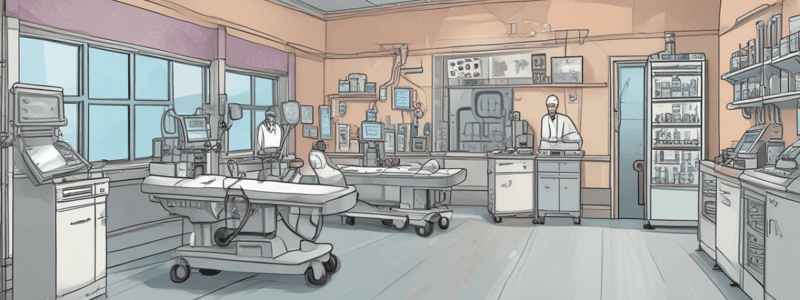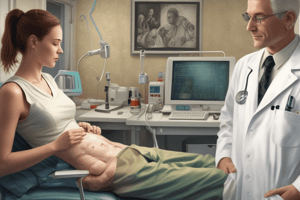Podcast
Questions and Answers
What is the primary goal of providing safe healthcare?
What is the primary goal of providing safe healthcare?
- To reduce waits and sometimes unfavorable delays
- To avoid injuries to patients from the care intended to help them (correct)
- To provide care that is respectful of patient preferences
- To provide services based on scientific knowledge
What is the main purpose of providing timely healthcare?
What is the main purpose of providing timely healthcare?
- To provide services based on scientific knowledge
- To avoid waste of equipment and supplies
- To ensure patient values guide all clinical decisions
- To reduce waits and sometimes unfavorable delays (correct)
What is the primary focus of family-centered healthcare?
What is the primary focus of family-centered healthcare?
- Reducing waste of equipment and supplies
- Providing care that is based on scientific knowledge
- Avoiding injuries to patients from the care intended to help them
- Providing care that is respectful of patient preferences and values (correct)
What is the main goal of providing efficient healthcare?
What is the main goal of providing efficient healthcare?
What is the main characteristic of equal healthcare?
What is the main characteristic of equal healthcare?
What is the primary cause of most errors in healthcare?
What is the primary cause of most errors in healthcare?
What is the primary characteristic of latent errors in healthcare?
What is the primary characteristic of latent errors in healthcare?
What is the primary characteristic of active errors in healthcare?
What is the primary characteristic of active errors in healthcare?
What is the recommended dose of adrenaline (epinephrine) in anaphylaxis?
What is the recommended dose of adrenaline (epinephrine) in anaphylaxis?
What is the definition of patient safety?
What is the definition of patient safety?
Which approach focuses on the errors of individuals, blaming them?
Which approach focuses on the errors of individuals, blaming them?
Why do adverse events often occur?
Why do adverse events often occur?
What is the result of blaming and punishing individuals?
What is the result of blaming and punishing individuals?
What can be done to improve patient safety?
What can be done to improve patient safety?
What are the two main categories of system errors in healthcare?
What are the two main categories of system errors in healthcare?
What is the term for the failure of a system to prevent a potential accident?
What is the term for the failure of a system to prevent a potential accident?
What is the definition of patient safety according to the World Health Organization (WHO) and World Alliance for Patient Safety?
What is the definition of patient safety according to the World Health Organization (WHO) and World Alliance for Patient Safety?
What is the adverse event rate in KKUH (2014) according to the data?
What is the adverse event rate in KKUH (2014) according to the data?
Why is patient safety a significant problem?
Why is patient safety a significant problem?
What is the main goal of patient safety?
What is the main goal of patient safety?
Which of the following is a consequence of patient harm?
Which of the following is a consequence of patient harm?
What is the primary goal of adhering to national Patient Safety Goals and Required Organization Practices (ROP)?
What is the primary goal of adhering to national Patient Safety Goals and Required Organization Practices (ROP)?
What is the purpose of medication reconciliation in patient safety?
What is the purpose of medication reconciliation in patient safety?
In the case study, what was the primary cause of the patient's adverse reaction?
In the case study, what was the primary cause of the patient's adverse reaction?
What is the importance of client/patient verification in patient safety?
What is the importance of client/patient verification in patient safety?
In the case study, what could have prevented the patient's adverse reaction?
In the case study, what could have prevented the patient's adverse reaction?
What is the purpose of reporting adverse events in patient safety?
What is the purpose of reporting adverse events in patient safety?
What is the primary goal of hand hygiene in patient safety?
What is the primary goal of hand hygiene in patient safety?
What is the purpose of infusion pumps training in patient safety?
What is the purpose of infusion pumps training in patient safety?
What is an example of a latent or system error?
What is an example of a latent or system error?
What is the Swiss Cheese Model of Accident Causation?
What is the Swiss Cheese Model of Accident Causation?
What is a patient safety culture?
What is a patient safety culture?
What is a characteristic of a blame culture?
What is a characteristic of a blame culture?
What is the result when the 'holes' in the Swiss Cheese Model align?
What is the result when the 'holes' in the Swiss Cheese Model align?
What is an example of an external factor that contributes to latent or system errors?
What is an example of an external factor that contributes to latent or system errors?
What is the purpose of the Swiss Cheese Model?
What is the purpose of the Swiss Cheese Model?
What is the goal of a patient safety culture?
What is the goal of a patient safety culture?
Flashcards are hidden until you start studying
Study Notes
Patient Safety
- Patient safety is the avoidance, prevention, and amelioration of harm from healthcare providers.
- 1,000,000 injuries/year occur in U.S. hospitals, and 44,000 – 98,000 deaths are caused by medical error/year.
- There are more deaths annually from healthcare than from road accidents, breast cancer, and AIDS combined.
Error and Harm
- Errors in healthcare can be caused by active failures (human errors) or latent conditions (system flaws or organizational failures).
- Most errors are not a result of human error or negligence, but arise from system flaws or organizational failures.
Key Elements of Healthcare Quality
- Safe: Avoiding injuries to patients from the care that is intended to help them.
- Effective: Providing services based on scientific knowledge to all who could benefit and refraining from providing services to those not likely to benefit.
- Timely: Reducing waits and sometimes unfavorable delays for both those who receive and those who give care.
- Family-Centered: Providing care that is respectful of and responsive to individual patient preferences, needs, and values.
- Efficient: Avoiding waste, in particular waste of equipment, supplies, ideas, and energy.
- Equal: Providing care that does not vary in quality because of personal characteristics such as gender, ethnicity, geographic location, and socio-economic status.
System Errors
- Active (human) errors: committed by frontline staff and tend to have direct patient consequences.
- Latent (system) errors: arise from system flaws or organizational failures, such as understaffed wards, inadequate equipment, and insurance paperwork.
Swiss Cheese Model of Accident Causation
- The system has many holes, some from active (human) failures and others from latent (system) conditions.
- The typical accident occurs because several human errors occur at all levels in the organization in a way that makes the accident unavoidable.
Patient Safety Culture
- An integrated pattern of individual and organizational behavior, based on a system of shared beliefs and values, that determine the organization's commitment to quality and patient safety.
- Two types of responses to mistakes: blame culture and just culture.
Case Study
- A patient receives 1mg of adrenaline IV instead of 0.3-0.5mg IM, which leads to harm.
- Contributing factors to the error: lack of communication, inadequate labeling of syringe, lack of care with potent medication, and not double-checking what it is.
National Patient Safety Goals
- Adhere and follow national patient safety goals/required organization practices (ROP).
- Adverse event reporting, client/patient verification, medication reconciliation, control of concentrated electrolytes, and others.
Studying That Suits You
Use AI to generate personalized quizzes and flashcards to suit your learning preferences.




